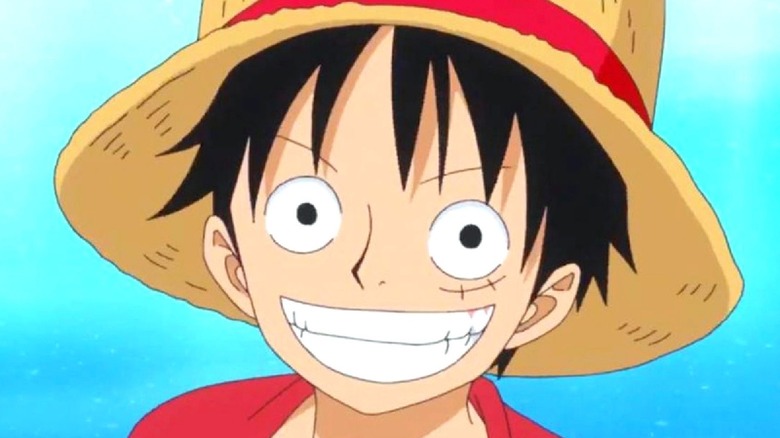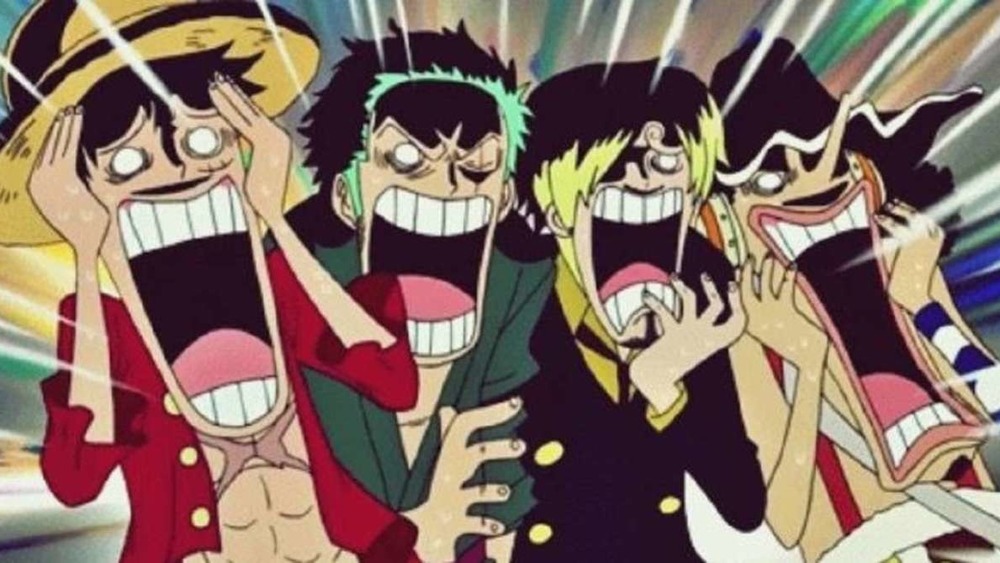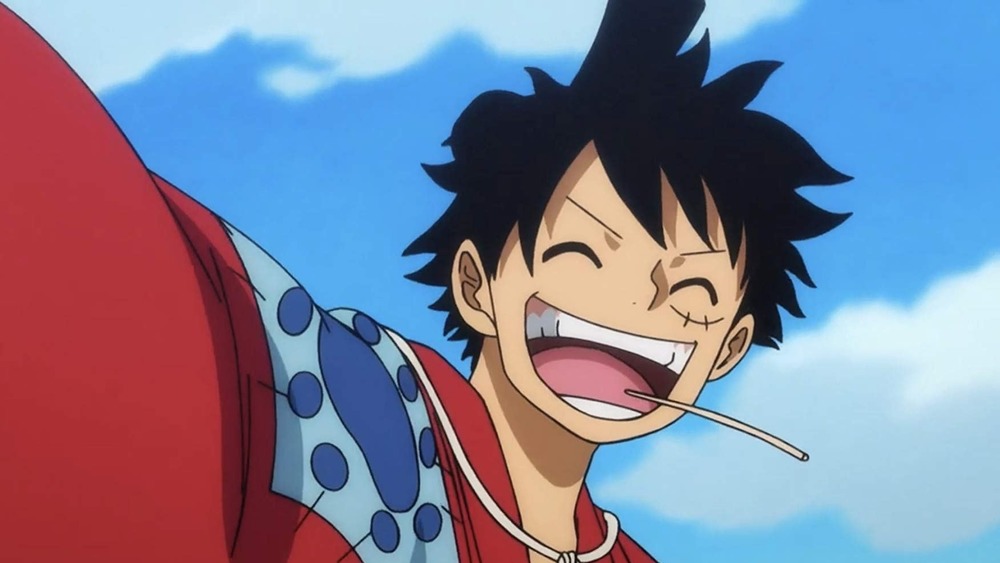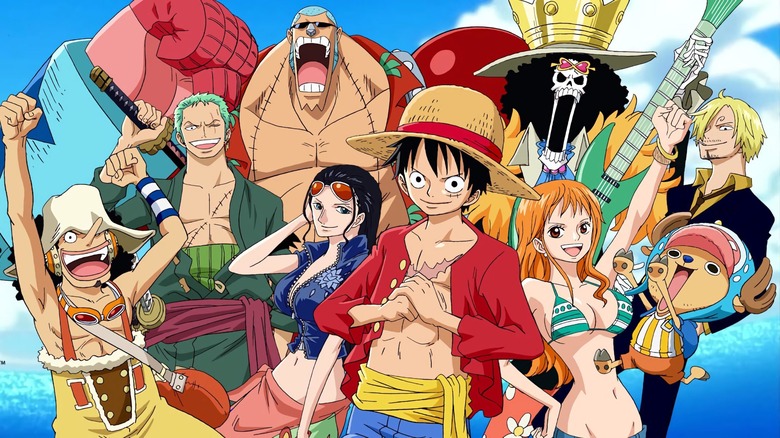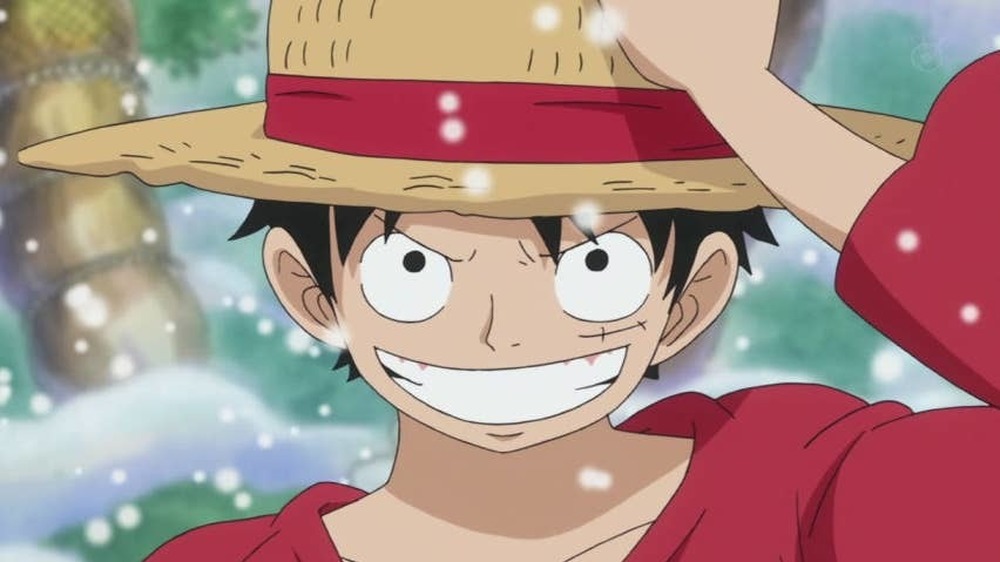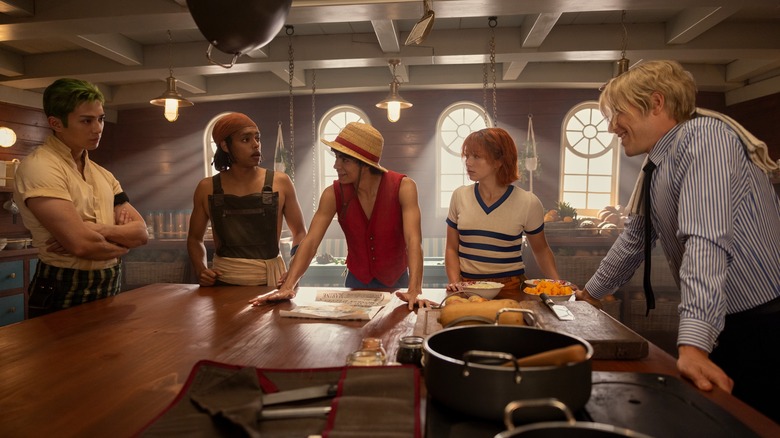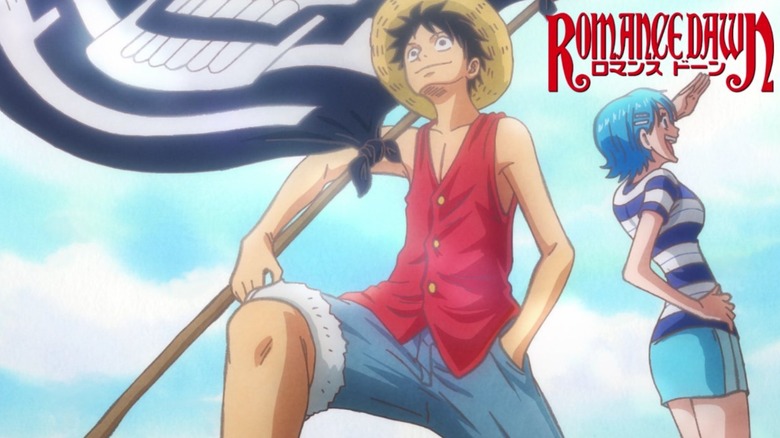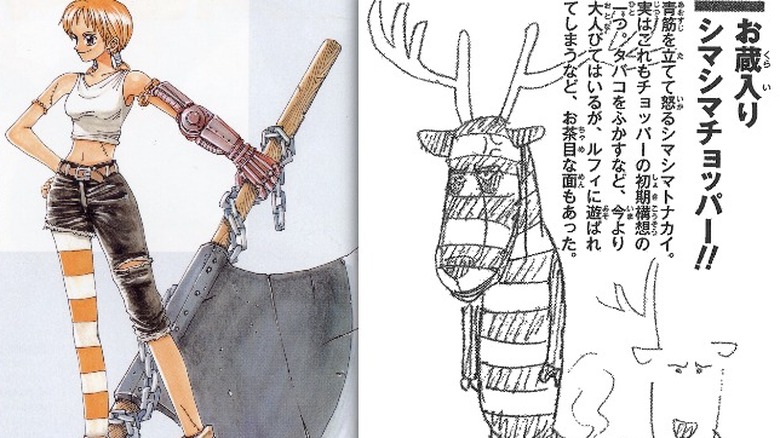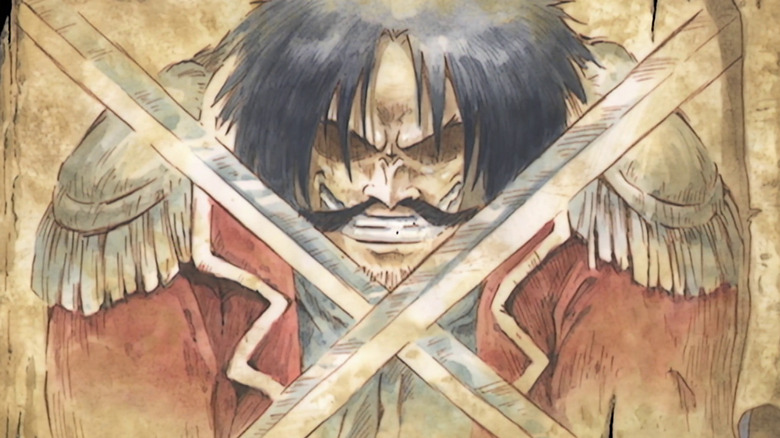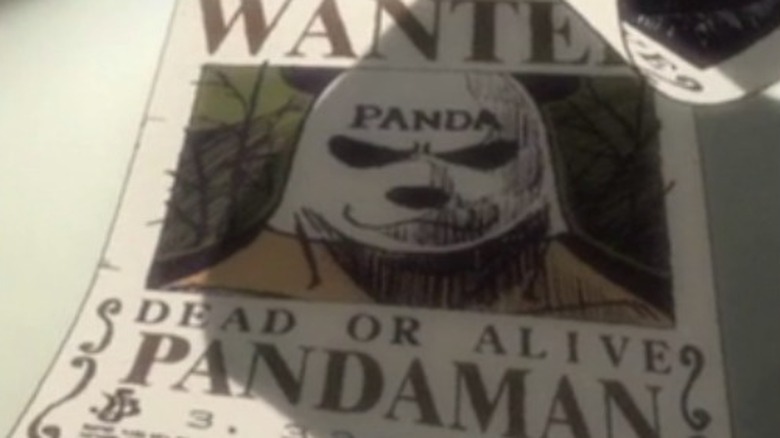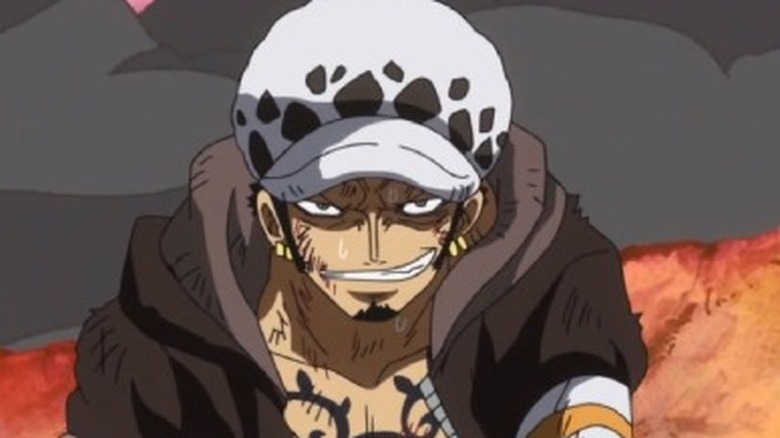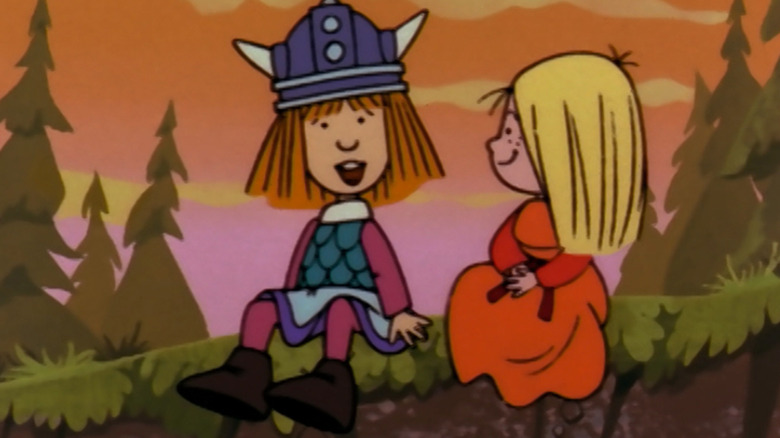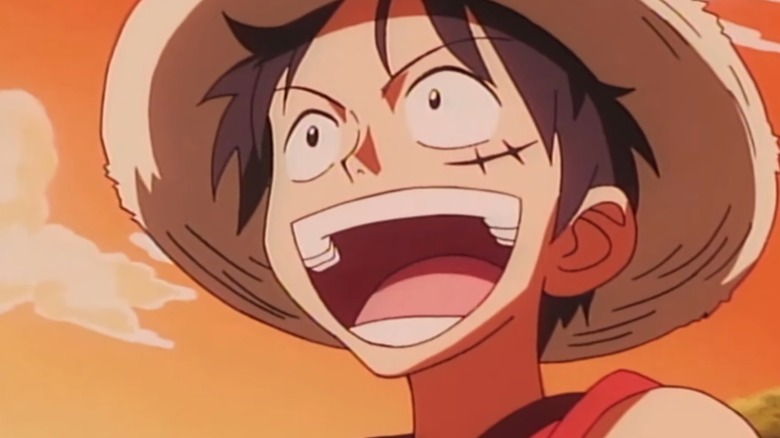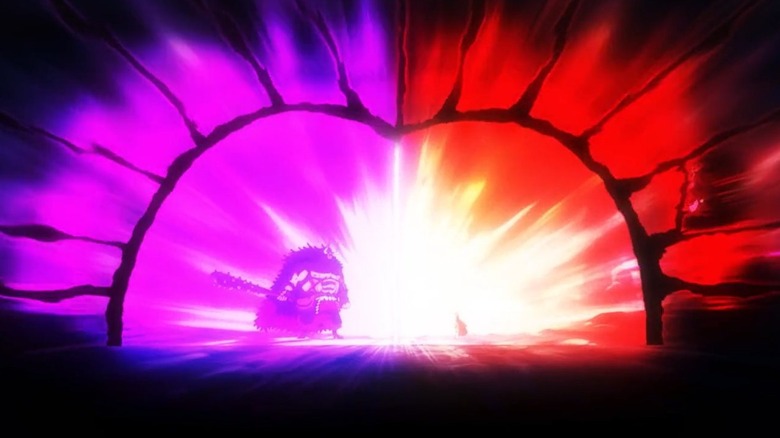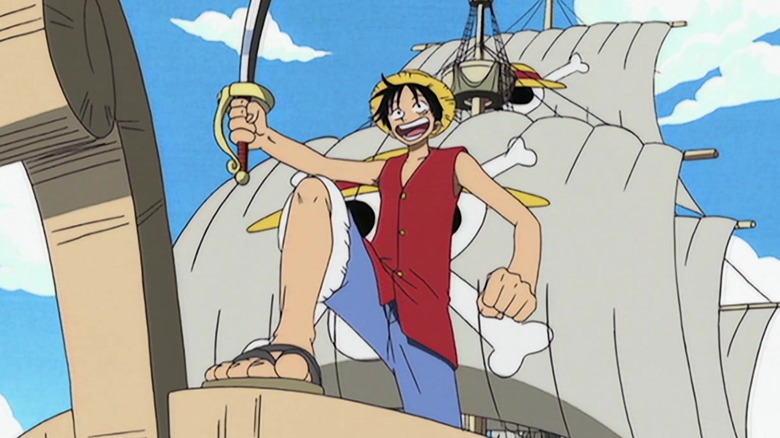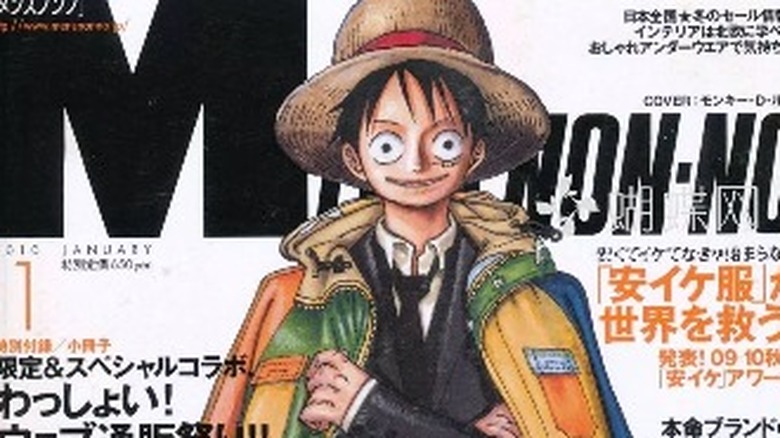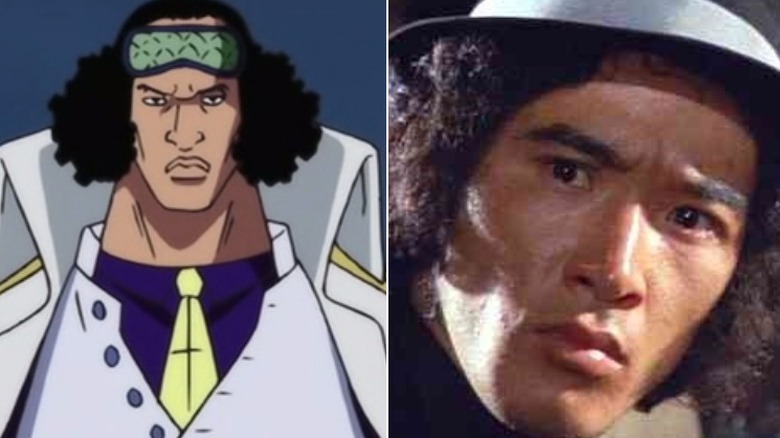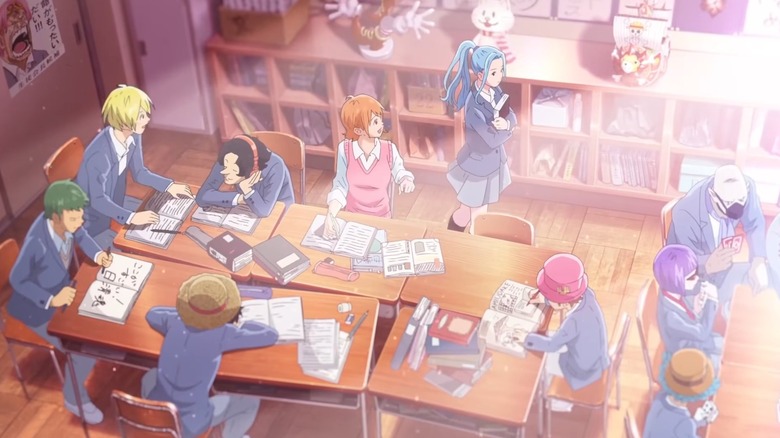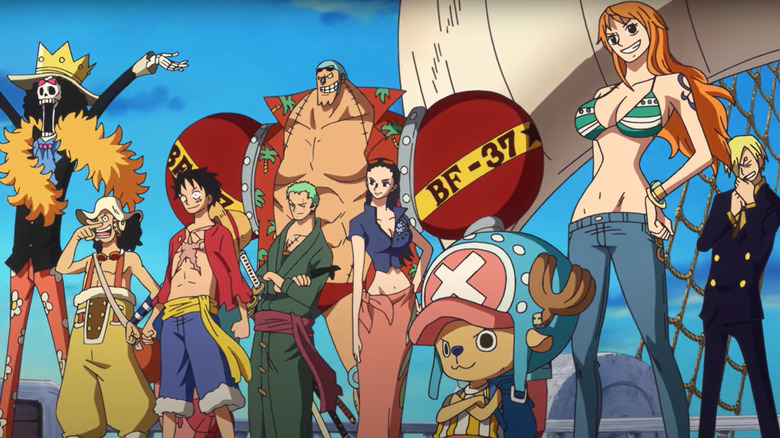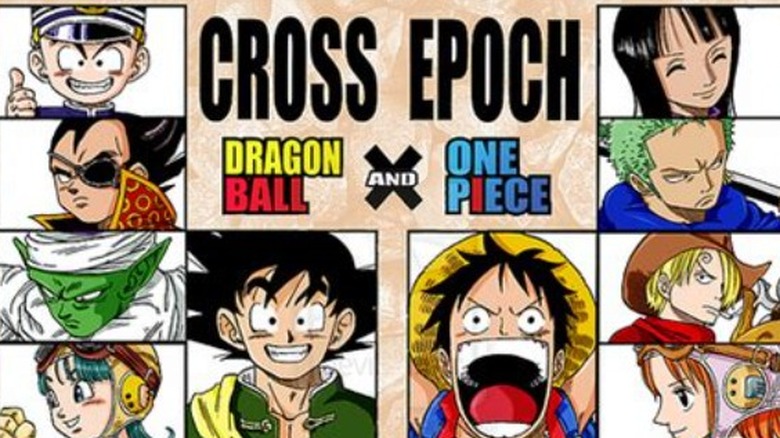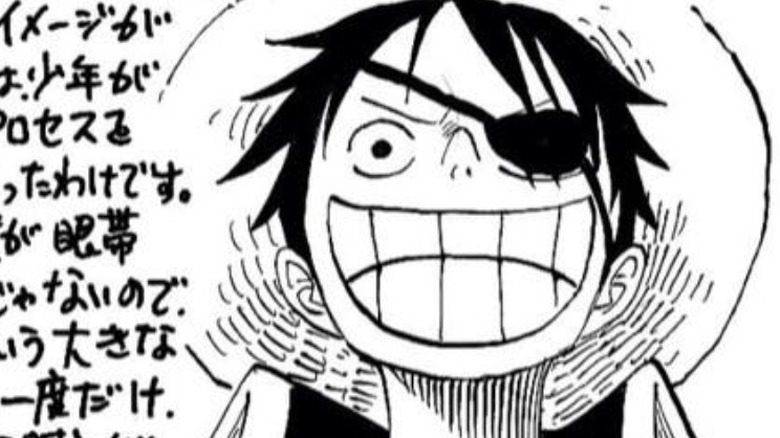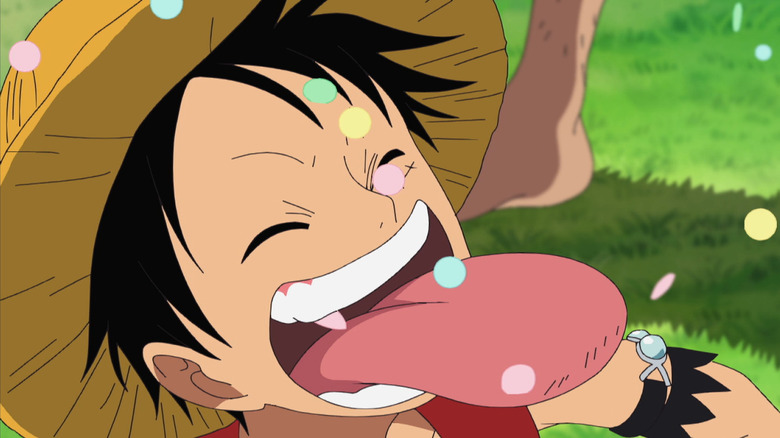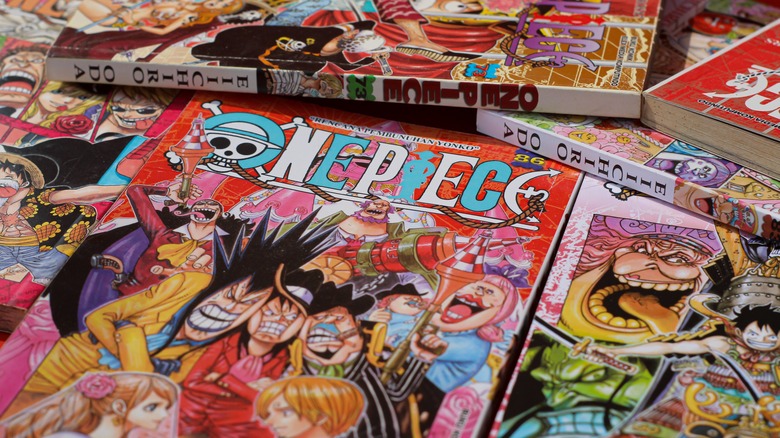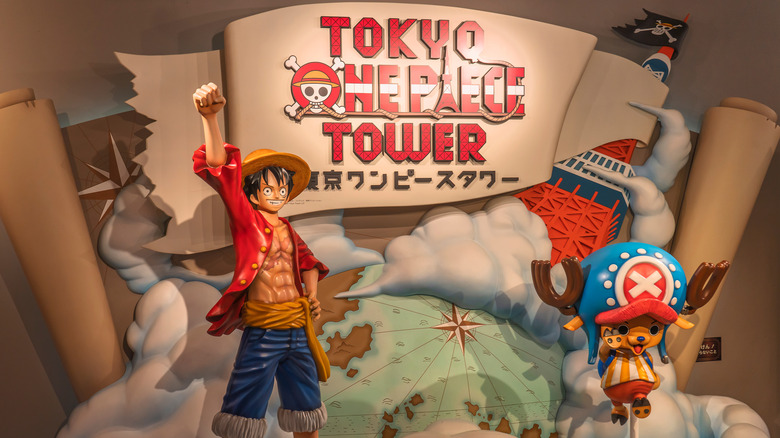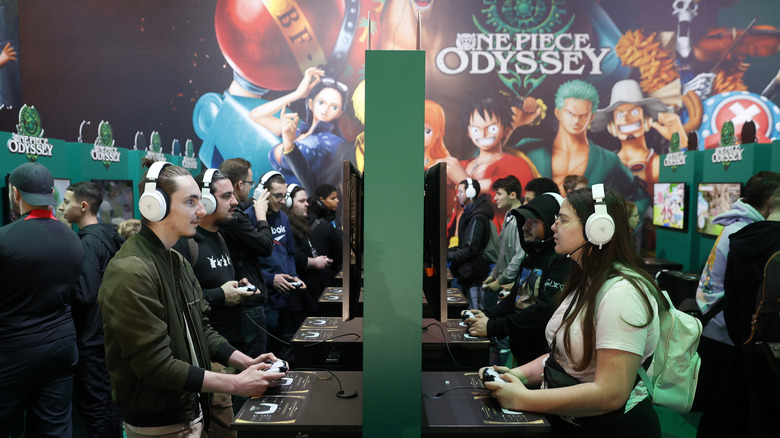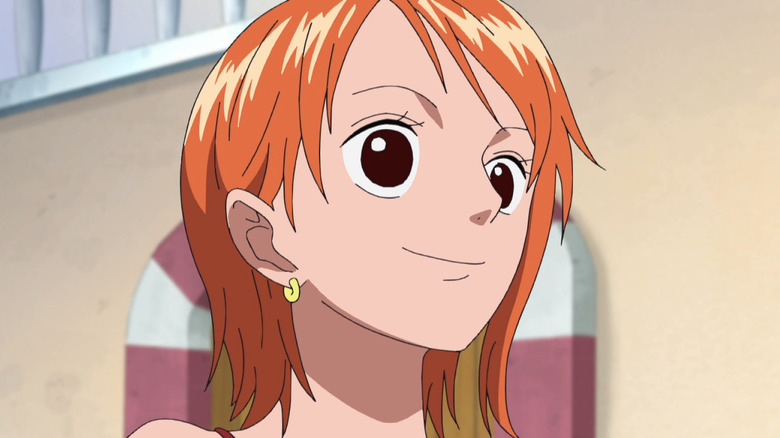The Untold Truth Of One Piece
Although it's only a couple of decades old, "One Piece" has quickly become one of the biggest stories in the worlds of both manga and anime. In part because the premise is so simple, the show became something that fans glommed onto and refused to let go of. The world of "One Piece" is now massive, but its core elements have remained largely the same.
The story follows Monkey D. Luffy, a young man who decides to travel to the East Blue Sea in order to search for treasure. Along the way, he picks up a crew and a gallery of supporting characters that are perfectly cast to play off of one another. The series has evolved from this relatively simple conceit, and Luffy and the gang have gotten into various adventures and picked up new characters along the way. Fundamentally, though, "One Piece" is a show about lovable people setting sail together in order to pursue their dreams. Here are some things you may not have known about the popular franchise.
One Piece has sold more than 500 million copies
"One Piece" is immensely popular. The manga had over 480 million copies in circulation in 43 countries in 2021: 400 million circulating in Japan, and another 80 million in countries around the world. By August 2022, the total number of copies sold had exceeded half a billion. There were "416,566,000 copies in Japan and 100 million copies outside of Japan in 60 regions around the world," IGN reported. "One Piece" is definitely most popular in Japan, but it's clearly a big deal everywhere.
Although the manga accounts for a huge part of the franchise's total gross, it's not the only source of income for "One Piece." When combined with revenue from TV shows, merchandise, feature films, and other products, "One Piece" has become a global phenomenon. Even though the series is still being run by its original creator, Eiichiro Oda, "One Piece" has expanded far beyond what he initially created into a global entertainment powerhouse.
One Piece's creator was inspired by Dragon Ball
Given the enormous success of both "One Piece" and "Dragon Ball," it makes sense that Eiichiro Oda was inspired in part by what Akira Toriyama had done with his series. The folks at the "One Piece Podcast" translated an interview between Oda and "Naruto" writer Masashi Kishimoto, in which the former called Toriyama influential.
"I'd have to say that Toriyama-sensei has been a huge influence," he explained. "Of course, there's 'Dragon Ball,' but I really loved 'Dr. Slump,' as well." Although the rules of each universe are different, the core elements of "One Piece," and the rogue cast of characters at its center have a lot in common with the motley crew that Goku assembles over the course of "Dragon Ball."
In a conversation with Toriyama, Oda even acknowledged that he had fallen in love with "Dragon Ball" the second he stumbled across it. "I fell in love at first sight. I thought, 'He's too good!'" Oda explained. "At that time, I loved Disney, but I was thinking, 'This is even better than Disney stuff!'" Oda also said that there were specific things about the art style in the series that inspired him, including the way that Toriyama drew muscles and hands.
Eiichiro Oda works an intense schedule
Although we could forgive Eiichiro Oda for deciding to rest on his laurels after creating one of the most profitable stories in history, that's not the path he chose. Instead, Oda continues to work a very intense schedule, and does a lot of the drawing for "One Piece" himself. This process means that Oda is often working exceedingly long days and suggests that he demands a lot of himself in order to make sure that the stories in "One Piece" are told the way he wants them to be. Oda reportedly wakes up at 5 a.m., and continues working on through 2 a.m. the next day, and rarely takes a day off, even on weekends. "One Piece" became an enormous success in part because of Oda's attention to detail, and it seems even now that it's world famous, Oda still wants to make sure his story is told with as much precision and care as possible.
If that sounds to you like it's a difficult schedule to maintain, you're right. Oda takes regular breaks from "One Piece" but has also been candid about overworking, exhaustion, burnout, and the health issues that can be caused by these things. Creating a work-life balance is difficult for working artists around the globe and has deeper societal causes than individual choices can fully account for, but here's hoping that Oda takes all the breaks he needs to complete the final saga of "One Piece."
One Piece was originally supposed to last for five years
Like many hugely important creators, Eiichiro Oda initially thought that he would be able to end the story of "One Piece" after five years, according to a translated quote found on an Amino anime blog. Although Oda knows how the series will end, he realized it would take him longer to get there than he had initially suspected. He also acknowledged that he liked the story too much to wrap it up that quickly, and ultimately decided to keep it going much longer than originally planned.
In 2019, Oda said that he predicts "One Piece" would end within the next five years. The series is on its way toward a definitive conclusion, and at this point, that ending is still the one that Oda envisioned when he initially planned to end the series after five years. Although the series will have run for more than 25 years by the time it actually ends, Oda is clearly committed to seeing his vision for the manga's ending realized.
There's a live-action version of One Piece on Netflix
"One Piece" has already expanded into a wide array of media, including "One Piece" movies, video games, and a hugely successful anime. Finally, in 2023, the live-action adaptation debuted on Netflix. The show was originally supposed to start filming in Cape Town in 2020, but production was delayed because of the pandemic. Inaki Godoy stars as Monkey D. Luffy; Mackenyu is Roronoa Zoro; Emily Rudd is Nami; Jacob Romero Gibson is Usopp; and Taz Skylar is Sanji.
The live-action "One Piece" admittedly caters to American fans of the series, but it also works as part of Netflix's broader push to reach a larger international audience. "One Piece" is a global property, and with Oda serving as an executive producer on the series, fans around the world can be comfortable that this new adaptation will continue to work as yet another part of the franchise. Plus, with a second season officially greenlit, fans have more of the live-action adventure to look forward to.
Romance Dawn
Much like how "My Hero" was a pilot of sorts for "My Hero Academia," "Romance Dawn" by Eiichiro Oda was a prototype for the "One Piece" story. The first version of "Romance Dawn" was a 50-page one-shot published in the "Shōnen Jump 1996 Summer Special" on August 4. The second version was only 45 pages long and released in the 41st issue of Weekly Shonen Jump the following month.
Both versions share similar elements that are present in the finalized version of the manga while differing in many ways. For example, Monkey D. Luffy is more concerned about going on fun adventures than becoming king of the pirates. Additionally, the two female leads from the respective versions of "Romance Dawn" — Silk in the first version and Ann in the second version — are clear prototypes of Nami. The Devil Fruits are also said to come from a mystical tree in the second version of "Romance Dawn," while their origin is still a mystery in "One Piece." Finally, Red-Haired Shanks sacrifices his left arm to save Luffy's arm and gives Luffy his straw hat in the first version of the story; in the second version, Luffy is inspired by his pirate grandfather who shares the same characteristics as Luffy's grandfather, Monkey D. Garp, in "One Piece."
"Romance Dawn" has been adapted in various ways. The first version was adapted as an anime special called "One Piece: Romance Dawn Story." The second version became Episode 907 of the TV anime series. The first episode of the live action "One Piece" series is called "Romance Dawn," and it's featured in the video game "One Piece: Pirate Warriors 3."
A completely different pirate crew
While Monkey D. Luffy went through minimal changes through the various prototypes of "One Piece," the remaining members of the Straw Hat Pirates went through various changes in their initial development before becoming the pirates they are today. The characters of Silk and Ann from "Romance Dawn" paved the way for Nami in the finalized story. However, according to the fourth databook, "One Piece Green: Secret Pieces," Nami originally had a giant battle-axe as her signature weapon instead of a bō and was going to be a cyborg. Additionally, the adorable Tony Tony Chopper was originally a more realistic reindeer who walked on two legs and smoked.
In an interview with Shōnen Jump, Eiichiro Oda said the reason why he changed Chopper's original appearance is because it blended too much with the other characters, so he made Chopper more distinct, cute, and small. Other changes include the former pirate hunter Roronoa Zoro originally being envisioned as the bodyguard for Buggy the Star Clown. And the chain-smoking cook Sanji was going to be named Naruto, however, with the "Naruto" manga about to start serialization, Oda wisely changed the name to avoid any confusion between the two characters.
The real age of piracy
The fantasy world of "One Piece” might be a work of fiction, but many of the series' outlandish characters are inspired by real-life pirates from the 17th century. Gol D. Roger, arguably the most important character in "One Piece," shares inspiration with two real-life pirates. The first is the French pirate Olivier Levasseur who, upon his hanging, tossed a cryptogram from the scaffolding into the crowd and told them if they could figure out the message his treasure would be theirs. Levasseur's treasure was never found. Similarly, Gol D. Roger tells pirates everywhere to go look for his treasure, the One Piece, before he's executed by the World Government. The second source of inspiration for Gol D. Roger is Henry Every, an English pirate who led possibly the most profitable pirate raid of all time in 1695. After capturing a treasure estimated at around $95 million in today's currency, Every became known as "The Arch Pirate" for his tremendous wealth. There are other examples of real-life pirate references in "One Piece," such as the real "Blackbeard," Edward Teach inspiring Marshall D. Teach, leader of the Blackbeard Pirates. There's also the Welsh pirate Bartholomew Roberts serving as inspiration for Bartholomew Kuma, the legend of Awilda for "Iron Mace" Alvida, and the Irish pirate Anne Bonny for Captain Jewelry Bonney.
Pandaman
Easter eggs in anime are pretty common, and "One Piece" is no exception to the rule. One of the most prominent and commonly deployed Easter eggs of Eiichiro Oda is Panadaman, an anthropomorphic panda wrestler he drew for a "Kinnikuman" character creation contest when he was a teenager, as he explained in Vol. 7 of the "One Piece" manga. As a joke character, Pandaman has been featured in various materials such as anime, manga, movies, and video games. His lore even unfolds in various backgrounds, as his love interest Pandawoman, his angry unpaid creditors the Tomato Gang, and his great rival the Unforgivable Mask have all made cameos in Oda projects. There are also faux fashion brands that Oda loves to reuse in "One Piece," such as Doskoi Panda and Criminal. Lastly, Oda isn't above shameless self-promotion, as both his name and the name of the series itself shows up in the background of "One Piece."
No flipping the bird
Even though "One Piece" gets away with a lot more than your average kids' cartoon in the U.S, it still has a younger-skewing audience in Japan. Therefore, the anime tends to water down the manga's most graphic moments. Case in point — characters who give the middle finger in the manga do not do so in the anime. There are various examples of characters flipping the bird to others in the manga, so much so that it became a running gag. The one character most associated with this offensive gesture is Trafalgar D. Water Law. When Law meets the Eustass Kid at the Human Auctioning House, he gives him the middle finger. In the anime, Law simply shoots Kid a smug grin. When Donquixote Doflamingo defeats Law in the "Dressrosa" arc of the manga, Law gives him the middle finger in defiance. The anime version dulls the edge of this rebellious moment by having Law verbally mock Doflamingo instead.
Vicky the Viking
There's no question that the works of "Dragon Ball" and its ilk played a huge role in the development of "One Piece," but there's one obscure series that doesn't get enough credit for inspiring Eiichiro Oda. As he's stated in numerous interviews, Oda became fascinated with the world of pirates thanks to a little 1974 cartoon called "Vicky the Viking." The show — which aired in Austria, Germany, and Japan — follows a boy named Vicky who is the son of Halvar, chief of the Viking village of Flake. Despite being feeble, shy, and terrified of wolves, Vicky manages to get himself and his fellow Vikings out of the toughest situations thanks to his sharp imagination. Interestingly enough, "One Piece" isn't the only anime inspired by "Vicky the Viking." Makoto Yukimura, the writer and illustrator of "Vinland Saga," has also cited "Vicky the Viking" as a source of inspiration and even drew some of the main characters from the kids' show as cameos in his manga.
The Production I.G. OVA
Before Toei Animation became the home of "One Piece," Production I.G. was the first animation studio to adapt Eiichiro Oda's manga into an anime. Production I.G. — the anime studio behind shows like "Haikyu!!," "Psycho-Pass," and "Ghost in the Shell" — produced an original video animation (OVA) of "One Piece" for the 1998 Jump Super Anime Tour, an event that celebrated the 30th anniversary of Shōnen Jump. Eschewing a straight adaptation of an existing storyline, the OVA is an original story penned by Oda that primarily features Monkey D. Luffy, Nami, and Roronoa Zoro taking down a nasty pirate named Ganzack and his crab-like pirates.
It may seem strange that Production I.G. didn't land the TV rights to "One Piece" after their work on the OVA, but this practice isn't uncommon, as pilot OVAs shown at Jump Festa are often done by different anime studios than the ones chosen for TV production. A recent example of this is Studio Pierrot producing the "Black Clover" TV anime series in 2017 after 2016's "Black Clover: Jump Festa Special" OVA by Xebec Inc. The director of the Production I.G. OVA was Gorô Taniguchi, who went on to direct the 2022 theatrical film "One Piece Film: Red." The OVA was even shown during a five-hour promotional stream for "One Piece Film: Red."
A little bit of animation controversy
The "One Piece" TV anime series from Toei Animation has been on the air since 1999. During that time, the show has undergone various changes in its animation style. The recent adaptation of the "Wano Country" story arc, for example, has experienced some significant changes in the show's art style. Of course, change isn't always a bad thing.
Episode 1015 of "One Piece," directed by Megumi Ishitani, was praised as one of the most visually stunning episodes in the series history. However, not everyone is on board with the stylistic changes to the show. A few fans have harassed animator Henry Thurlow online, believing him to be the cause of the show's controversial use of power auras that recall fight scenes from "Dragon Ball Z." To his credit, Thurlow took it in stride and poked fun at the thought of any single animator having so much creative control over a mega-franchise like "One Piece."
There have also been "One Piece" fans who have apologized for the harassment Thurlow has received and offered their support. On the "One Piece Podcast," Thurlow clarified the anime's use of auras, stating that the decision of when to use it and by how much is decided by the individual episode directors; for instance, Tu Yong-ce requested to tone down the aura effects for Episode 1033.
The One Piece rap
Thanks to the work of Funimation-slash-Crunchyroll, the "One Piece" anime series has experienced a resurgence in popularity in North America. The series is widely available in its original form, subbed and dubbed, on various streaming platforms, in digital stores, and home media releases. Plus, films like "One Piece: Stampede" and "One Piece Film: Red" have been rolled out at North American theaters to commercial success. North American "One Piece" fans have it good.
That wasn't always the case, however, as the defunct 4Kids Entertainment originally owned the English rights to the "One Piece" anime and subjected it to countless questionable changes. Like most 4Kids dubs of its era, "One Piece" was heavily censored to ridiculous degrees. The 4Kids dubs were Americanized like crazy and had most of its original music replaced by an interchangeable track. Worst of all, some episodes of "One Piece" were skipped or merged into a singular episode. Needless to say, fans were not happy with these changes.
The lasting legacy of the 4Kids dub of "One Piece," however, is its American intro that tells the story of the Straw Hat Pirates through a reasonably corny rap song. Oddly enough, 4Kids also produced an English cover of "We Are!," the first "One Piece" anime opening song but decided against using it. While hardly anyone mourns the loss of 4Kids and their rights to "One Piece," the fandom has embraced the 4Kids "One Piece" intro music. After all, how many other classic anime series can say they've got a rap theme song? And who can hate a line like "Yo-ho-ho he took a bite of Gum Gum!" Shawn Freshco Conrad, the man behind the rap, explained how the theme song came to be. He even updated the rap for the crew members that don't get to appear in the 4Kids dub.
One Piece and fashion
Who says Monkey D. Luffy doesn't have class? While everyone's favorite straw hat-wearing hero hasn't become king of the pirates just yet, he has set an unexpected milestone in the real world. He became the first anime character to grace the cover of Shueisha's Men's Non-No fashion magazine in 2009. This is an amazing feat considering the publication's 24-year history at the time. It also marked the first time Eiichiro Oda had drawn a cover image for a non-manga magazine.
Admittedly, there might have been some bias at play here, as Shueisha is also the publisher of Weekly Shonen Jump magazine. Nonetheless, Luffy got to show off some killer threads by stylist Shinichi "Miter" Mita, all while keeping his straw hat on. The first eight pages of the magazine also featured photographs of real-life models who resembled Luffy, Nami, Nico Robin, Roronoa Zoro, and Sanji. All of them wore clothes that played into the theme of sea and pirates.
The real-life inspirations for the three Marine admirals
Various aspects of "One Piece" have been influenced by historical figures and real-life events. When designing the three significant marine admirals from the series — Kuzan (aka Aokiji), Borsalino (alias Kizaru), and Sakazuki (alias Akainu) — Eiichiro Oda turned to three late but great Japanese actors as a source of inspiration for their appearances.
Kuzan is based on the late Japanese actor Yūsaku Matsuda who starred in films like "The Beast to Die," "Detective Story," and "Black Rain." Matsuda's status as an actor is so legendary that he also serves as inspiration for Kenshiro from "Fist of the North Star" and Spike Spiegel from "Cowboy Bebop." Borsalino is based on the late Japanese actor Kunie Tanaka who appeared in films like "The Bad Sleep Well," "Sanjuro," and "Battles Without Honor and Humanity." Finally, Sakazuki is based on the late Japanese actor Bunta Sugawara.
Hungry Days
As "One Piece" is hardly above promoting products now and again, a series of "One Piece" noodle commercials reimagined the cast as modern-day high schoolers. The advertising campaign was called "Hungry Days" and it was for the Japanese food company Nissin Foods to advertise their lineup of instant noodles.
The modern-day designs of the Straw Hat Pirates were drawn by Eisaku Kubonouchi ("Carole & Tuesday") and animated by Shaft Animation Studio. In the ad campaign that ran from May 2019 to February 2020, each commercial focused on a crew member that evoked emotional moments from the series related to that crew member, only reinterpreted to fit the present-day high school theme. The first commercial had Roronoa Zoro swearing to get stronger after losing a kendo match to Dracule Mihawk. The second has Nami being overwhelmed by her high school studies and evening work at the Arlong Pirates' restaurant. The third commercial has Nefertari Vivi recalling precious memories of her high school friends (the Straw Hat crew) as she transfers to a new school. The fourth is an all-out brawl between the White Team (Whitebeard Pirates) and Red Team (Marines) in a kibasen event involving Monkey D. Luffy and his brother Portgas D. Ace.
The nationalities of the cast
One of the great things about the "One Piece" series is the communication between fans and series creator Eiichiro Oda. Through the question-and-answer column in the manga, Oda often answers fans' lingering questions about the world of "One Piece," no matter how ridiculous the questions may be. For Volume 56 of the question-and-answer column, there was one fan who had a more serious question: "If One Piece was set in the real world, which countries would the nine Straw Hats come from?" Oda's response: "Well. I'll just put what fits with the character's image." Here's what Oda put down:
"Luffy: Brazil
Zoro: Japan
Nami: Sweden
Usopp: Africa
Sanji: France
Chopper: Canada
Robin: Russia
Franky: USA
Brook: Austria"
Obviously, Africa is a continent and not a country. Whether or not Oda has an extremely limited knowledge of global geography, or simply didn't think hard enough about this particular fan question is unknown.
One Piece x Dragon Ball
Considering the love and admiration Eiichiro Oda and Akira Toriyama have for one another, it was inevitable that the two manga creators would work together on a crossover involving their popular series. And keeping true to their wacky sense of humor, the highly anticipated "One Piece x Dragon Ball" crossover was anything but normal.
Similar to "Mashima HERO'S" that mashed "Rave Master," Fairy Tail," and "Edens Zero" into one, "Cross Epoch," takes the cast of "One Piece" and "Dragon Ball" and puts them in a far-out story where Mr. Satan invites everyone to a little tea party after using the Dragon Balls to wish to be king. In the end, the "Dragon Ball" and "Once Piece" crews all make it on time and have fun. Some of the characters' appearances and occupations are changed to better mirror one another — Bulma becomes a thief to match Nami, Piccolo masters sword fighting to reflect Roronoa Zoro.
This isn't the only time "One Piece" and "Dragon Ball" have crossed over with each other, as they often appear together in various Shōnen Jump-related games like "Battle Stadium D.O.N" or the ill-fated "Jump Force."
No eye patch?
According to series creator Eiichiro Oda, "One Piece" is entering its final story arc, meaning the series' quarter-century journey will soon come to an end. There's no telling where this ship will sail for its final destination, but there's one thing that everyone can be certain of — before the series is complete, at least one character in "One Piece" will wear an eye patch.
Confused? In the over one thousand chapters of "One Piece," there has not been a single pirate with an eye patch. The same is true for the TV shows and movies. Why? According to Oda in the "One Piece 10th Treasures" special collectors' book, he said he wanted to avoid the stereotypical pirate look. "It's not like every pirate has an eye patch!!!," Oda wrote. "You can totally draw pirates without an eye patch!!!!"
Oda is not against the idea of drawing a pirate with an eye patch — he's just more interested in the journey that gets them there. "And with that thought in mind it all began; the story of a normal-looking boy's pirate story. I thought, if there's an image in everyone's head about what a pirate is, then I thought I would write [and] draw about the process of the boy getting there. But it's not like I dislike eye patches, so in the final scenes of One Piece, there is one pirate who appears with an eye patch."
Fans have speculated that the fabled eye-patch-wearing pirate character could be Monkey D. Luffy, as the story of "One Piece" has been his journey from a young dreamer to king of the pirates.
Guinness World Records
In addition to the truly wild number of copies the manga has sold, "One Piece" also holds the title for the most copies published for the same comic book series by a single author, according to Guinness World Records. The record was set in 2015 and renewed in 2022 as Oda's incredible output has remained unmatched. In true Oda form, his humble response statement noted that the way "One Piece" brings people together is the true star of the show, going on to elaborate on his intention to keep the quality high to honor both the award and the world of manga as a whole.
This isn't the only record-breaking title under the "One Piece" banner. According to Guinness, a fan from Hong Kong named Lam Siu Fung is now the record-breaker for the biggest "One Piece" memorabilia collection. Clocking in at 20,125 pieces as of 2023, Fung stores this treasure trove in a warehouse. He has spent around $75,000 on his always-growing monument to Oda's masterpiece. Fung's collection includes three straw hats signed by Oda, which he wears while cosplaying as Luffy. Other items range from the relatively inexpensive to highly sought-after keepsakes. "Lam owns 'One Piece' umbrellas, jigsaw puzzles, alarm clocks, snow globes, sleeping masks, passport covers, a dustbin, and pretty much every other object you could think of," Guinness confirmed.
If at first you don't succeed
One of the wildest revelations about "One Piece" is that it could very well have never existed at all. In an interview with TBS in Japan, the manga's first editor Takanori Asada said that it was rejected multiple times by executives at Weekly Shonen Jump. Asada explained how he went to bat for the series, persisting in hopes of convincing the higher-ups that "One Piece" was well worth taking a chance on. "Asada was frustrated with his bosses due to those rejections," Twitter user @sandman_AP, who translated the interview, said. "He even had a dream at night that he beats up his bosses." Eventually, Asada's commitment to bringing the story to the magazine made a dent in the opposition, and the rest is history.
Oda has maintained that his interest in manga is merely an amusing way to pass the time and avoid getting a real job. Yet, he's been in the game since he was only 17, creating his first work, "Wanted," in 1992. Indeed, he's mused in the past that he very well might have gone into film production if not for the emotional staying power he found with manga. This just goes to show that even great works that seem fated to exist see plenty of forks in the road. In this case, we're thrilled that "One Piece" came to fruition, though it's fun to imagine what kind of movies might have come from the mind of Oda.
The One Piece theme park killed off by COVID
There have been a few real-world monuments to "One Piece" over the years, though the biggest of the lot is sadly no longer open. "One Piece" opened its own theme park inside Tokyo Tower in 2015. Though it closed because of the coronavirus pandemic in 2020, the indoor park featured a number of games and rides based on characters and storylines from the series. It also sported several restaurants and seasonal events, making it a pilgrimage for superfans.
The experience "Luffy's Endless Adventure" walked fans through the history of the character with a combination of full-size statues and panels, ending with a short film available only through the park. Games and tours, as well as other interactive elements like photo spots, made up the majority of the attractions. Gone but not forgotten, this remains one of the coolest IRL manifestations of "One Piece" to date, although Universal Studios Japan hosted a themed rollercoaster that also sounds pretty amazing: The "One Piece x Hollywood Dream the Ride – Departure! Mini Merry II" ran from July to October in 2022.
One Piece video games
Besides the presence in manga and anime that "One Piece" has achieved, it has been the inspiration for so many video games that there is a full Wikipedia page dedicated to listing them all. While many of these games fall into the role-playing category, they span consoles and formats. It's a wide-ranging selection for video game enthusiasts all around the world.
Not only has the "One Piece" gang appeared in over forty games in the last two decades or so, but characters from the series also make regular appearances in various Shonen Jump crossover games, like "Jump Super Stars." Regardless of what you play on, there is likely a "One Piece" game out there for you, as the franchise has made appearances on everything from Gameboy to PlayStation to mobile apps and beyond.
"One Piece" has also served as the inspiration for light novels, music, art books, a trading card game, and museum exhibitions. As influential as the "One Piece" manga is, it's always finding new realms through which to shine.
Oda met his wife through One Piece
Nami joined the Straw Hat Pirates all the way back in the "Orange Town" arc, making the navigator one of the most prominent members of the gang. She's also one of the most popular characters in "One Piece" history, meaning that there are plenty of people all around the world with a go-to Nami costume ready for conventions in their closets. One such person is Chiaki Inaba, who was cosplaying as Nami at Jump Festa in 2002 when she met her husband-to-be, none other than Eiichiro Oda himself.
The former model and Oda began dating, and the two were married in 2004. There has been a lot of commentary around Inaba's uncanny resemblance to Nami, but otherwise, there's not a ton of information about her. They have stayed wed to this day, apparently living separately due to Oda's work schedule but still remaining close. Oda is a fairly private person so the ins and outs of his family life aren't public knowledge, but the couple is known to have two daughters together.
